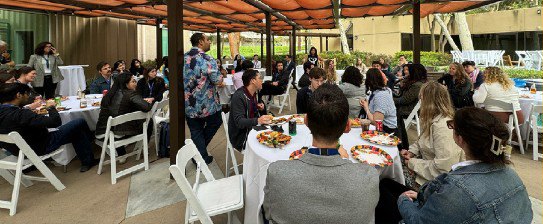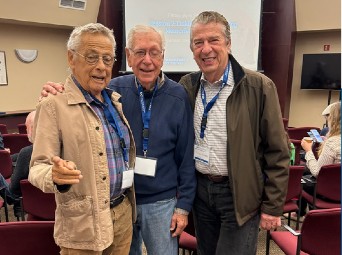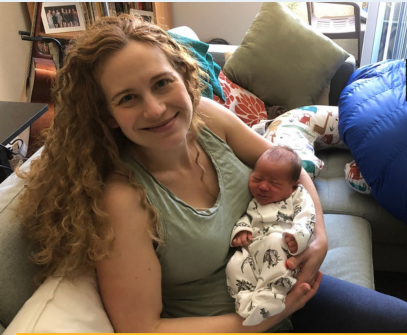2024 CNLM Spring Meeting
Chronicles of Memory
Unveiling the Temporal Enigmas of the Brain

CNLM founder Dr. James McGaugh holds up the 2024 CNLM Spring Meeting t-shirt in front of the Herklotz conference room.
Since 1983, the Center for the Neurobiology of Learning and Memory (CNLM) has annually brought together heavyweights in learning and memory research to the University of California, Irvine to present and discuss emerging topics. The 2024 theme, “Making TIME (Temporally Integrated Memory for Events),” piqued the interest of 145 attendees, filling the Herklotz conference room for both days, April 25th and 26th.
CNLM Director Michael Yassa kicked off the conference by explaining the inspiration behind the creative poster and t-shirt graphic for the conference. The graphic included a sepia-toned western landscape with figures surrounding a DeLorean, a nod to the famous time-traveling machine in Back to the Future. The outline of the figures resembles the organizing committee members, Drs. Laura Ewell, Norbert Fortin, Gary Lynch, Christine Gall, and Michael Yassa, affectionately referred to as “The TIME Bandits.”
“Learning and memory scientists are tackling one of the most mind-bending riddles of our time: how do our brains organize information in time?” said Yassa. “The 2024 CNLM Spring Conference seeks to push our understanding of encoding, segmentation, storage, and recall of events across species and levels of analysis.”
The first conference session was on “Temporal Signals and Periodicity.” Soledad Gonzalo Cogno from the Norwegian University of Science and Technology presented research on ultra-slow oscillations—slow patterns of activity in the brain that may affect memory, behavior, and perception—in rat brains. Dr. Zahra Aghajan from UCLA, showed similar slow oscillations in human brains, happening over different time scales. She shared that these rhythms may complement spatial signals to help establish a spatiotemporal metric for human experience. Dr. Bradley Lega from the University of Texas Southwestern Medical Center illustrated how our brains mark boundaries and order events, using data from intracranial recordings in patients with epilepsy.
A mainstay of the CNLM Spring Meeting is allocating 50% of symposium time to discussion. Session 1 moderator Dr. Liz Chrastil from UC Irvine facilitated a lively discussion with topics ranging from the implications of different temporal timescales, to how to make wormholes in time, to the expansion and contraction of time in our perceptions.

Conference attendees gathered in the CNLM lobby on the second day of the conference for a group photo.
After lunch in the CNLM Courtyard, a place steeped in memory with pathways made of engraved bricks highlighting the accomplishments of memory researchers and trainees from the last 40 years, attendees headed back to the auditorium to hear from faculty in the Open Paper Session.
The Open Paper session is designed to give faculty attendees who are not presenting in the symposium sessions an opportunity to present research in short, 10-minute presentations. This year, five faculty members from multiple universities, including UC Irvine, UC San Diego and Mount Sinai, presented. Session moderator, Dr. Christine Smith from UC San Diego summarized the talks by saying, “These talks covered memory phenomena from milliseconds to decades, identifying how brain structure and function change in health, pregnancy, and disease.”
Conference attendees welcomed the afternoon poster session by first fueling up at the cold brew station (a new and popular addition to the 2024 conference) and exploring 45 posters lining the halls of the CNLM.
Two notable poster presenters received travel awards to attend the conference; Undergraduates Pamela Perez-Vazquez and Alison Santos-Marquez traveled from Puerto Rico to UC Irvine as part of NeuroBridges, a CNLM collaboration with Puerto Rico-based non-profit Neuroboricuas which aims to empower young Puerto Ricans to engage in science.
“We are honored to support our Puerto Rican trainees,” said Dr. Manuella Oliveira Yassa, CNLM Director of Outreach and Education. “I am inspired by the rigor of their science and their enthusiasm for research. The future of neuroscience is in good hands!”
The afternoon culminated with a Data Blitz Session—an exciting, fast-paced series of five-minute presentations where trainees are challenged to present one finding in only one slide. An anonymous panel evaluated the 14 presentations and awarded the top two presenters—Kate Lawson (UC Irvine) and Luca Kolibius (Columbia University)—a UC Irvine goody bag, and more importantly, bragging rights.

Drs. Denise Cai and Michael Yassa hosted an evening discussion in the CNLM courtyard on the future of graduate neuroscience education.
Featured speaker Dr. Denise Cai (Mount Sinai) and CNLM Director Michael Yassa capped off the day with a casual evening discussion about the future of graduate neuroscience education over pizza and drinks. Trainees from all stages voiced their opinions and hopes for the future of academic training and their mentors listened and gave advice.
Facilitating constructive dialogue is one of the pillars of the CNLM and helped bolster the inclusive and supportive culture at the conference.
By day two, conference attendees were intellectually fueled and ready for more discussions. “Session 2: Linking and Integrating Memories Over Time I” was moderated by Dr. Christine Gall from UC Irvine. The first speaker, Dr. Tomás Ryan from Trinity College Dublin, discussed forgetting as a mechanism of adaptive engram plasticity, highlighting how the brain's ability to forget certain information can actually be beneficial. Dr. Kaori Takehara-Nishiuchi from the University of Toronto focused on how acetylcholine, a neurotransmitter, regulates the incorporation of past experiences of threat into decision-making processes in the medial prefrontal cortex. Dr. Laura Ewell from UC Irvine examined how the hippocampus encodes and rapidly updates information about changing rewards. Together, these talks provided insights into the complex mechanisms underlying memory and decision-making in the brain while also offering opportunities for discussion of alternative hypotheses.
During the discussion, one such difference-of-opinion came up when Dr. Denise Cai gave a cliffhanger for her upcoming session by bringing up a long-standing dissension between her and Dr. Ryan about the permanency of engrams, the neural substrate of memory. Dr. Ryan believes that engrams are static and don’t randomly change because of noise, time, or passive forgetting. Dr. Cai disagrees and believes that engrams are dynamic and constantly changing. During the next session, these dynamics were further explored.

Drs. Gary Lynch, James McGaugh, and Michel Baudry pose for a photo during the second session.
They were among the 46 scientist present at the inaugural Spring Meeting in 1982.
The “Session 3: Linking and Integrating Memories Over Time II” speakers delivered insights into various aspects of memory and its neural mechanisms.
Dr. Denise Cai discussed how memory stability and flexibility change over a lifetime, shedding light on the dynamic nature of memory processes. Dr. Josh Jacobs from Columbia University delved into the neural dynamics of episodic memory encoding, revealing how ripples and traveling waves in brain activity contribute to the formation of memories in humans. Dr. Norbert Fortin from UC Irvine presented an intriguing perspective on the hippocampus, suggesting that it serves as a "wormhole" for encoding sequential relationships among complex event sequences. Dr. Eitan Schechtman expertly navigated the discussion session by focusing first on trainee questions and then inviting panelists to ask each other about their work.
The session was attended by some of our most prominent CNLM Fellows including Drs. James McGaugh, Gary Lynch, and Michel Baudry, who were among the 46 scientists present at the inaugural Spring Meeting in 1982.
The final session of the day featured Dr. Dean Buonomano, who energized the room with his keynote address titled, “Timing, neural dynamics, and working memory.” Dr. Buonomano is a professor of neurobiology at UCLA and has been described as one of the first neuroscientists to pose the question, “how does the human brain encode time?” During his talk, Dr. Buonomano explained that the perception of time in the brain involves complex interactions across many different brain areas, and it relies on the way groups of brain cells interact with each other over time. These groups of cells are thought to create neural sequences and may constitute a special code for representing time. This code can help other parts of the brain know when to do things and at what time. The talk also mentioned that our brains are good at predicting when we'll need to remember something and for how long, and this ability is essential for working memory.

CNLM Director of Outreach and Education Dr. Manuella Oliveira Yassa plays Puttskee during the Spring Meeting BrainFest in the courtyard.
The day ended with a BrainFest–a celebration involving games, conversation, and delicious food. Conference attendees and staff were spotted playing Rattlesnake Round Up (a ring tossing game), Giant Jenga, and Puttskee in the courtyard.
The 2024 CNLM Spring Meeting proved to be a memorable event, bringing together luminaries and rising stars in the field of learning and memory. From the thought-provoking symposium sessions to the inspirational discussions happening in the hallways, attendees were treated to a wealth of insights into the intricate workings of the brain's temporal mechanisms and memory processes. As the final day drew to a close, it was evident that the conference had not only advanced our understanding of temporal cognition but also fostered a sense of community and collaboration among attendees.
 IN THE NEWS
IN THE NEWS
CNLM Fellow Dr. Liz Chrastil presented preliminary research at the 2024 Spring Meeting Open Paper Session on how pregnancy impacts the brain.
The kicker—the research stemmed from Chrastil’s own pregnancy. Chrastil volunteered to have her brain scanned 26 times before, during and after pregnancy to see how the flood of hormones that accompany gestation might change its structure.
"The fact that we don’t know what happens to the brain when someone gets pregnant is remarkable. This is a fundamental question."
Liz Chrastil, Ph.D.
Associate Professor
UC Irvine
Browse the Spring/Summer 2024 NeuroTimes
This article was featured in the Spring/Summer 2024 NeuroTimes. You can read the entire edition by clicking on the link below.


